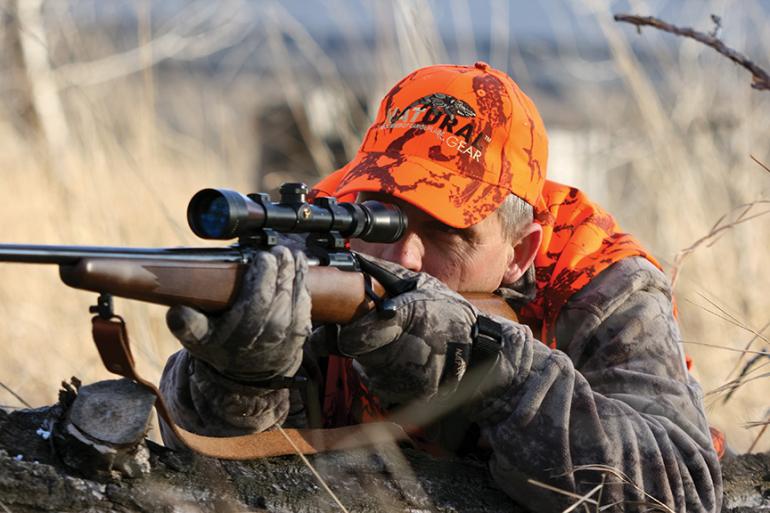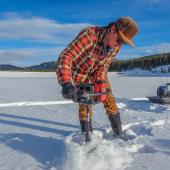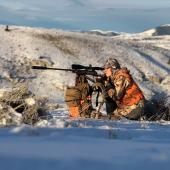Marksmanship 101
Shooting effectively and ethically.
More than just hitting what you aim at, shooting well is about hitting that mark under all conditions. It’s about killing your quarry as quickly and humanely as possible. It’s about being confident with your shooting in the clutch, when the adrenaline is pumping and the wind is howling.
Everyone knows a friend who pulls his gun out of storage from last season, dusts it off, grabs some random rounds from coat pockets, maybe shoots a few rounds at a pie plate, then drops his elk with one shot. More commonly what happens is an animal has its leg blown off or struggles on for miles, sometime in the next day or two becoming carrion.
Very few of us are natural shooters; we’ll get lucky every now and then, but we can’t drill the bull’s-eye with any real consistency. So it comes down to one thing: practice. And it’s really not enough to lie out the blanket, put the rifle on a rest, and head home when you’ve got three shots in the black. You have to shoot under field conditions, which often means standing or kneeling shots, against trees, at dusk, and in inclement weather.
Steady Position
The first fundamental of good marksmanship is having a steady position. Assuming your rifle is in good repair, or at least was hitting what you aimed at last year, start by setting up a bench or blanket rest at your favorite shooting spot. Take your time and get comfortable. Your cheek should rest on the buttstock in the same place every time—try to bring the rifle to your head, not your head to the rifle. Now pull it in firmly into your shoulder socket, so it can’t accelerate into your shoulder after firing. Your lead elbow should be directly under the barrel, not pointing out to the side. Remain focused but consciously relaxed—you shouldn’t be tense as you begin sighting your target.
Proper Breathing
Set up the target at 50-100 yards, depending on how much shooting you’ve done with your rifle. You’ll wreck your confidence by moving out too far, too quickly. Now that you have the target in the crosshairs and a good steady position, it’s time for the second fundamental: proper breathing. Monitor your breath while you’re in good position. Watch how it affects your sight picture; it’ll have a bit of a rhythm. There is a moment of natural respiratory pause while breathing when most of the air has been exhaled from the lungs and before you inhale again. You want to practice shooting at this pause, but before feeling much discomfort. Take your time and practice this timing with the chamber empty and the bolt open.
Trigger Squeeze
Now that you have a steady position with your breath control figured out, trigger squeeze is the last main fundamental. The key is that the trigger finger must squeeze the trigger to the rear smoothly, so the hammer falls without disturbing the lay of the rifle. It’s not a pull, but a slow squeeze, so that it almost surprises you each time. When a live round is fired, it’s difficult to see what effect trigger-pull had, so try some dry-fire training to ensure the hammer is falling with little disturbance to your aiming. Most people flinch or pull a little, anticipating the kick—this can move your rifle and thus throw your round off-target. A good dry-fire exercise is to put a penny flat on the end of the barrel and then try to squeeze the trigger without making the penny fall off. Alternate with a live round now and then to keep it realistic.
In just a few outings, you’ll be able to move further back and practice from standing and kneeling positions. When you get more confident, have a buddy count down from five and make the shot before he gets to zero. That adds a little stress to simulate field conditions. Anything you can do to make it more like actual hunting will pay off in spades. Use a life-sized animal poster; shoot when it’s cold, windy, or near dark. But mainly, get out and shoot and try something other than shooting prone on a bench rest. You’ll have a ton more confidence and fun out hunting knowing you’ve prepared.
Range Time
Practice makes perfect, and when it comes to accurate shooting, there’s no better practice than time at the range. Alas, with Bozeman’s booming population, sighting in your rifle at a random trailhead is no longer tenable. The good news is that there are plenty of private ranges around southwest Montana. Here’s a rundown.
Logan Range
Operated by the Manhattan Wildlife Association, this is the area’s most popular facility. The main rifle range goes out to 440 yards, which is plenty far for the average hunter. Membership involves a mandatory safety video, which can be viewed at the Gallatin County Fairgrounds; guests can accompany a member for a daily fee. Note: beware of range nazis, gun nerds who talk your ear off, and yahoos who don’t follow proper range etiquette.
Livingston Range
About the same distance from Bozeman, the Park County Rod & Gun Club has targets out to 500 yards. It’s a smaller, more laid-back place with an old-school vibe. Pick up a membership at Yellowstone Sporting Goods in Livingston.
Tactic
This SEAL-led shooting school offers long-range instruction out to 1,000 yards and beyond. The range is near Four Corners and both private and group classes are available.
Fortress
Precision-shooting classes take place on a range near Three Forks, at distances out to 600 yards. Long-range engagement courses extend that to 1,500 yards. One-on-one or group instruction can be arranged. —the editors













